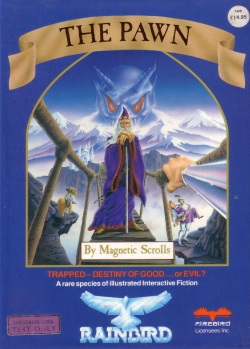
[Game covers and Jinxter screen taken from The Magnetic Scrolls Memorial and The Magnetic Scrolls Gallery]
Since The Pawn first took the software industry by storm, Magnetic Scrolls have acquired a reputation for producing first class adventures. Their latest game, Corruption, is about to enter the Spectrum’s chips. Set in the world of insider dealing, the City and the stockmarket, it marks an interesting departure from their previous fantasy games. Samara, Egyptian adventurer, materialised in their London offices and spoke to Magnetic scribes Ken Gordon and Anita Sinclair.
‘The beautiful facade of Le Monaco restaurant beckons you to take refuge from the screams of cars and buses which rush past along London Road, swerving dangerously close to the pedestrians as the road turns by the restaurant. The only other place to find some seclusion is in the park over the road to the west.’
At a distance of half a mile or so from this upmarket Corruption location in the City of London, south of the river between London Bride and Borough Station, lie the offices of Magnetic Scrolls. Nip down a grimy side alley, pass by a hearty-looking London pub, travel up in a rickety, rattling lift and you’re there. It’s a deceptively low profile for a company that has won practically every adventure accolade going including the prestigious British Micro Computing Game of the Year award for The Guild of Thieves.
So how do this small but successful company actually start? We spoke to Ken Gordon and Anita Sinclair.
‘When the QL came out, that looked like an opportunity for writing new, interesting games. When the ST came along with its added graphics the move was easy because they’re both 68000 machines. There was a gap in the market; nobody had got into 16-bit machines so we took the chance.’

They picked adventure rather than arcade games purely as a matter of personal preference. The product of this initial gamble was The Pawn. Set in the mythical land of Kerovnia, it was marketed by Rainbird and converted to run on a wide range of 16 and 8-bit formats ranging from IBM PC compatibles to Amstrad CPCs.
Each game takes about a year to develop. All primary work is carried out on a huge DEC Micro Vax linked to a series of individual terminals. With plenty of memory and disk space it’s associated with none of the initial problems of working within the restrictions of a smaller machine. Disks don’t corrupt and valuable bits of information don’t get lost. A couple of programmers work from home on comparatively fast Apricot Xens, but the bulk of the programming takes place on a system which provides more than enough opportunity to experiment.
What amounts to 80% of a game is written by two people, one specialising in the text and the other in coding but as their work overlaps, neither is a complete specialist. About two months before a game is due to be released, work starts on the individual versions. A specific format is assigned to each programmer: Ken, for example, has been working on the Amiga version of Corruption, Anita Sinclair on the ST. Meanwhile a small army of play-testers and bug-spotters is called into action.
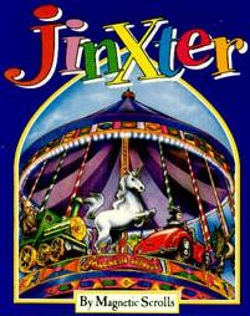
The characteristically attractive dark blue packaging is mainly Rainbird’s responsibility. They supply all the goodies to go in the box and suggest alterations on the text (usually supplied by Magnetic Scrolls) to go into the manuals.
The care that goes into the elaborate peripherals reflects the potential shelf life of each product. Ken Gordon:
‘Our idea of a nice product is not necessarily one that’s going to make number one in the charts but one that’s going to sell for years. We still sell reasonable numbers of The Pawn.’
Ken reckons that the games have been successful because of the amount of effort that has been put into them: ‘If we don’t get them something right it (the cause of the bug) will either come out completely or we’ll delay things so it is right. We try and produce the most high quality product we can. We aren’t in the same business as the people who sell their products at £1.99. It’s in the nature of an adventure that, in comparison with top quality arcade products, it has a longer-lasting shelf life.
‘Adventure games tend not to have as many bells and whistles as, say, a 3-D shoot-’em-up which needs to have features to appeal to the next generation of games players. Adventurers don’t have the same initial sales figures but new players are still buying comparatively old adventures for the first time.’
Over the years they’ve developed a whole range of in-house adventure utilities. What do they think of some of the finished systems available on the market now?
‘A lot of really good ideas get strangled because a system isn’t capable of expressing them. One of the most complex utilities available at the moment lets you have up to 500 flags and 500 counters — you couldn’t express one of our games in those terms. Without that extra flexibility, I could see it being very difficult to write a half-reasonable game using one of the adventure writing systems. The ones I’ve seen, even by people I’ve expected to do quite well, have been marginal.’
Magnetic Scrolls adventures, on practically every format other than the Spectrum, are well-known for their excellent illustrations. So where does Ken really stand in the great graphics versus text debate?

‘Graphics take a long time to do and they involve a lot of people, so they really have to add something to a game to be worthwhile. Originally we considered line drawings but we then decided to go for bit pictures. There’s fewer of them, but generally they’re of a higher quality. Corruption, for example, is set in the cut-throat environment of the City — it’s a dark and sleazy tale and the graphics help to convey this atmosphere. It’s one instance where the graphics actually help.
‘The trouble is that when a game is being developed we don’t work with the pictures; the design is largely coordinated by artists told about the story. They’re given descriptions of the rooms so that they make sense, but the illustrations can never be completely accurate. There may be a standard lamp in the picture that isn’t in the description. Try and look at it or do something with it and you draw a blank. Our graphics are illustrations really; they’re broadly correct but they aren’t too literal.’
‘Having said all that, I don’t mind playing games without graphics. If the graphics are really detrimental to the rest of the game then I’ll switch them off. In some cases this even speeds up a game which is all for the better.’
The comparatively poor graphics capabilities of the Spectrum weigh the balance in favour of text-only +3 versions.
‘We couldn’t use an ST picture on any Spectrum. A lot of our pictures can be reused. ST pictures can be converted to run on the Amiga or the PCW 8256 and the graphics capabilities of the Commodore 64 are similar enough to the CPC for us to get away with it. If we did graphics on the Spectrum, to get them up to the quality of our other games, we would have to redraw them and we can’t afford to do that on the basis of the sales that we expect. In any case, if the Spectrum did have graphics there’d be less memory to devote to the game and you’d have to go to disk more. Inevitably, that would slow the game down.
What do they think of the future of sound in adventures?
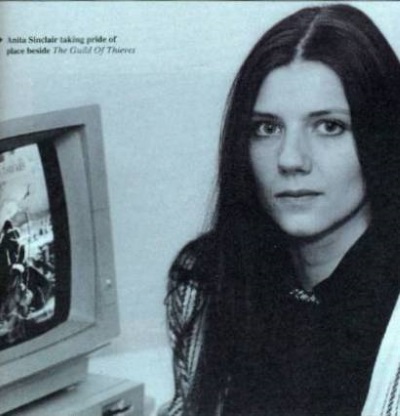
‘On the Amiga versions of our games you can opt for spoken descriptions and enjoy a bit of music. Unfortunately sound is really heavy on memory. It would be nice to have creeping footsteps. The Amiga is probably one of the main machines you could do this on. Certainly with its stereo capabilities you could have binaural creeping footsteps. It might be a bit unsubtle though, having to tell the user that he has to plug in his headphones and wear them because he may be in for a surprise!’
On the subject of icon-driven adventures their opinions are mixed.
‘These games do narrow down the possibilities a lot which is easier from the programmer’s point of view. You obviously have to cater for more possibilities if people can type anything they like. On the whole, I think these sort of games provide less of a challenge although there are one or two, like Mindscape’s Deja Vu which are really good. They cater for a more commercial market, but while there are still people who read and write books, there’s still room for a more conventional approach like ours.
‘Some games are a bit of both. In some respects they’re OK but then, is it really easier to click the mouse over an icon saying N or just type it anyway? On the other hand, we do incorporate pull-down-and-use menus in some of our games, make the descriptions brief or verbose, and so on. They’re useful because unless you’ve read right through the manual you won’t necessarily know they’re there.’
As for violence in computer games, Magnetic Scrolls don’t support a particularly pacifist stance. You can’t die in Jinxter but the concept was introduced primarily as a gimmick.
‘You CAN die in Corruption but the violence isn’t excessive. In fact, our games tend to suggest that force doesn’t get you anywhere very fast. Attack the old man in The Guild of Thieves or the guru in The Pawn and you’re dead. Blood and guts don’t usually have that much to add to a game. It may be justified in a film setting where you’re making an artistic point, but I don’t think you’re making that kind of point in a computer game. More often than not blood and gore is introduced as a marketing ploy, a form of teasing. If you really want to shock people then there are other ways of doing it.’
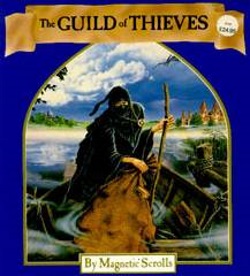
In fact Magnetic Scrolls are more in the business of shocking by contrast. The realistic setting of Corruption is a pretty drastic departure from the fantasy world of Kerovnia and an even more innovative game is due to be released later this year. Known simply as Fish! the adventure begins in the underwater environment of an ordinary goldfish bowl. The arrival of a tacky plastic castle turns your uneventful fishy life into a multi-faceted, action-packed experience. How could you possibly refuse the chance to explore?
That caters for the rest of this year. So far there aren’t any plans for another Kerovnian tale, but Anita Sinclair assures me that it’s a possibility; thought to recreate the familiar atmosphere, it would have to be written by the same people who wrote the first three games. As for what could possibly Fish! — cod knows.
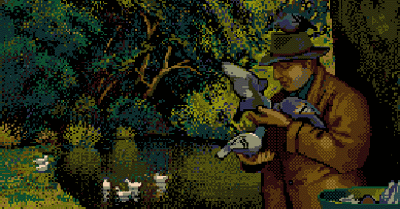
‘We couldn’t use an ST picture on any Spectrum’
There’s a new Magnetic Scrolls adventure out and you know exactly what to expect: dragons, wizards, the odd gnome, a quaint old English village, a princess. Right? Wrong!
In fact Corruption is set in the heart of the City of London. You’re the newly appointed partner in a firm of stockbrokers quietly settling in on your first day in the new job. Your office is spacious. there’s a highly efficient secretary next door, and downstairs in the garage your BMW awaits. Life is looking rosy. At least that’s how it seems. As time passes, you begin to realise that everything isn’t completely above board. Certain clues point to insider dealing and it soon becomes horrifyingly clear that you’re the chief suspect. Unless you keep your wits about you and manage to gather enough evidence to clear your name, you may never get to drive that BMW again.
The adventure clearly has a specialist appeal. Magnetic Scrolls feel that it’s more likely to win the support of an older audience, particularly players who already know something about the business world. Anita Sinclair is concerned that people should consider what the game is about before they buy it. Even if you’ve enjoyed Jinxter there’s no guarantee that you’ll like Corruption; it’s a completely different type of game. As a result the release has been given a comparatively low profile.
‘If we hyped this to the ends of the earth a lot of people who would end up buying it wouldn’t like it because they’d prefer a fantasy game. And that would put them off our future releases.’
So before you hand over your silver pennies, consider carefully whether you’re really destined for yuppieland.